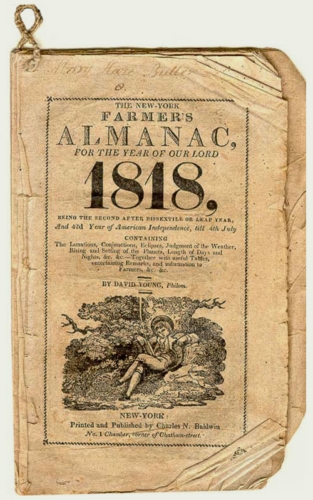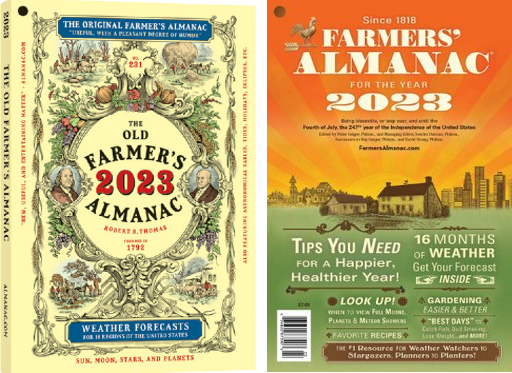When should I plant my garden? In my part of North Carolina the average last spring killing frost date is April 8. At least that is what the Cooperative Extension Service says. But wait a minute. The Old Farmer’s Almanac says it is April 3. So who should I believe?
I have been tracking the actual temperature since March 20 to see which prediction is most accurate.
| Date | Low Temperature | Date | Low Temperature |
| Monday, March 20 | 30 | Saturday, April 1 | 67 |
| Tuesday, March 21 | 28 | Sunday, April 2 | 45 |
| Wednesday, March 22 | 48 | Monday April 3 | 46 |
| Thursday, March 23 | 53 | Tuesday, April 4 | 59 |
| Friday, March 24 | 60 | Wednesday, April 5 | 64 |
| Saturday, March 25 | 56 | Thursday, April 6 | 70 |
| Sunday, March 26 | 57 | Friday, April 7 | 45 |
| Monday March 27 | 59 | Saturday, April 8 | 42 |
| Tuesday, March 28 | 46 | Sunday, April 9 | 42 |
| Wednesday, March 29 | 44 | Monday, April 10 | 37 |
| Thursday, March 30 | 39 | Tuesday, April 11 | 37 |
| Friday, March 31 | 51 | Wednesday, April 12 | 48 |
So which prediction was the closest? Climate change might have an impact on these dates. For your information I planted most of my garden on March 27 & 28.

Figure 1. Because of gunky red clay soil, I plant my garden in elevated beds made of recycled wood pallets that I obtain for free. To amuse the neighborhood kids (and adults), I added heads and paint to the planter boxes. Now the neighborhood kids can identify a Duroc hog, Holstein cow, etc. The zebra contains straw in which potatoes are planted.
For centuries (yes, centuries) farmers and gardeners have relied on The Old Farmer’s Almanac for gardening and farming advice. In this Footnote we will learn about the history and evolution of The Old Farmer’s Almanac and the upstart Farmers’ Almanac.
In the Beginning
Would you believe The Old Farmer’s Almanac started when George Washington was president. The Old Farmer’s Almanac was first published in 1792 (for the 1793 year) during George Washington’s first term as president. The word Old was added in 1832, dropped in 1836, but added back in 1848. I have inserted Old here to prevent confusion, more later. The Old Farmer’s Almanac sold for six pence (about 9 cents) and 3,000 copies were sold the first year. By the second year, circulation increased to 9,000 copies. The editor was Robert B. Thomas.

Figure 2. The 1793 edition of The [Old] Farmer’s Almanac.
What exactly is an almanac? According to Merriam-Webster it is “a book containing a calendar of days, weeks, and months and usually facts about the rising and setting of the sun and moon, changes in the tides, and information of general interest.“ However, The Old Farmer’s Almanac contained much more information than that. It offered farming and gardening advice plus items of general interest. The cover contains the phrase “useful, with a pleasant degree of humor.” which originated with Robert Thomas, the first editor.
The web site for The Old Farmer’s Almanac states it is “packed with wit, wisdom, folklore, weather predictions, home remedies, gardening advice, moon phase info, celestial happenings, fun facts, articles, tips, recipes, secrets of the zodiac, and much more that makes every day special throughout the year!”
The Old Farmer’s Almanac was not the first almanac. Several almanacs were published in America in the 1600s. Harvard University published a series of almanacs. Poor Robin’s Almanck appeared in 1664. Nathaniel Ames, a colonial American physician living in Bridgewater, Massachusetts started publishing an almanac in 1725. Ben Franklin started publishing Poor Richard’s Almanack in 1733. However, Ben’s brother, James, started the Rhode Island Almanack five years earlier, in 1728.
It did not take long for The Old Farmer’s Almanac to become popular. The format was like other almanacs, so what made it so popular? The current editor believes the popularity was because the “astronomical and weather predictions were more accurate, the advice more useful, and the features more entertaining” than other almanacs.
The founder, Robert B. Thomas, used a complex series of natural cycles such as solar activity, astronomy cycles and weather patterns to devise a secret weather forecasting formula, which brought uncannily accurate results, traditionally said to be 80 percent accurate. Even today, his formula is kept safely tucked away in a black tin box at the Almanac offices in Dublin, New Hampshire.

Figure 3. The tin box in The Old Farmer’s Almanac office where the secret weather forecasting formula is kept.
In 1851 the four seasons drawing by Henry Nichols appeared on the cover and has been featured on the cover ever since. During the remainder of the 1800s there was a heavy emphasis on scientific agriculture articles. However, during the early 1900s there was more of an emphasis on nature and modern life.
Over time there have been several editors. In 1936 Roger Scaife became editor and made a major blunder. He dropped the weather forecasts. Instead he published the temperature and precipitation averages. The public outcry was so great that he reinstated the forecasts in the next edition.
During World War II, a German spy was caught on Long Island, New York after being dropped off from a U-boat the night before. He had a copy of the (1942) Old Farmer’s Almanac in his pocket. The U.S. government speculated that the Germans were using the Almanac for weather forecasts (or perhaps the tide tables), which meant that the book was indirectly supplying information to the enemy. As a result, the almanac from 1943 through 1945 featured “weather indications” rather than “forecasts” in order to comply with the U.S. Office of Censorship’s voluntary Code of Wartime Practices for press and radio. The temporary change allowed the almanac to maintain its record of continuous publication.
The Almanac passed the four million circulation mark in the early 1990s. In 2000, Janice Stillman became the 13th (and first female) editor of The Old Farmer’s Almanac.
A Rival Farmers’ Almanac
In 1818 a publication called The New York Farmer’s Almanac was started in Morristown, New Jersey. However, the words “The New York” was in small print so Farmer’s Almanac was what stood out. This almanac had a blend of long-range weather predictions, humor, fun facts, and valuable advice on gardening, cooking, fishing, conservation, and much more.

Figure 4. The original 1818 Farmer’ Almanac.
This almanac is still published today and has a circulation of over six million copies. In 1955 the Almanac Publishing Company moved from New Jersey to Lewiston, Maine. Today, three versions of the Farmers’ Almanac exist. One is sold throughout the U.S. in retail stores such as supermarkets and bookstores. There is a promotional version which is utilized by businesses to promote their products and there is a Canadian version.

Figure 5. There is a difference. The Old Farmer’s Almanac (started in 1792) is on the left. The cover drawing has been used since 1851. The image on the right is the founder Robert B. Thomas. The image on the left is Ben Franklin and he had no connection to this Almanac. The Farmers’ Almanac (started in 1818) is on the right. Note that both publications have a hole in the top left corner. This is so they can be hung on a nail in the outhouse.
Concluding Remarks
There are those who farm, garden, fish and perform other activities according to The Old Farmer’s Almanac. This might be worthy of exploration for an Agri science Fair project.
This fall, when you are shopping for Christmas gifts, consider The Old Farmer’s Almanac. It is normally published in September for the following year. It might be a quirky but entertaining gift.
If you are a teacher there are a number of neat teaching activities that can be related to the almanacs.
- Show and discuss The Old Farmer’s Almanac documentary video. https://www.almanac.com/video/old-farmers-almanac-documentary
- Have your students go to the first and last frost dates in the online Old Farmers Almanac predictor and enter the school’s zip code. Then compare that date with what your state’s extension service says. Which do the students think is most accurate? It might be interesting to keep a log for a few weeks before the dates to see which is more accurate. https://www.almanac.com/gardening/frostdates
- Have your students interview neighbors to see if they go by the advice in The Old Farmer’s Almanac. What have their experiences been?
- Have your students go to the “Best Days” section of the Almanac and see if they agree with the suggested best days to perform various agricultural activities. Have them speculate on how the dates were determined. https://www.almanac.com/bestdays/timetable
- Need something to occupy time after a test? Have your students go to https://www.almanac.com/topics/explore-almanac/best-almanac-articles which are supposedly some of the best articles from the Old Farmer’s Almanac. Have them read one and report to the class.
- Both The Old Farmer’s Almanac and the Farmers’ Almanac have web sites. Have the students compare and contrast the information found on the two sites. Most of the information in this Footnote came from these two sites.
- The Old Farmer’s Almanac – https://www.almanac.com/
- Farmers’ Almanac – https://www.farmersalmanac.com/
